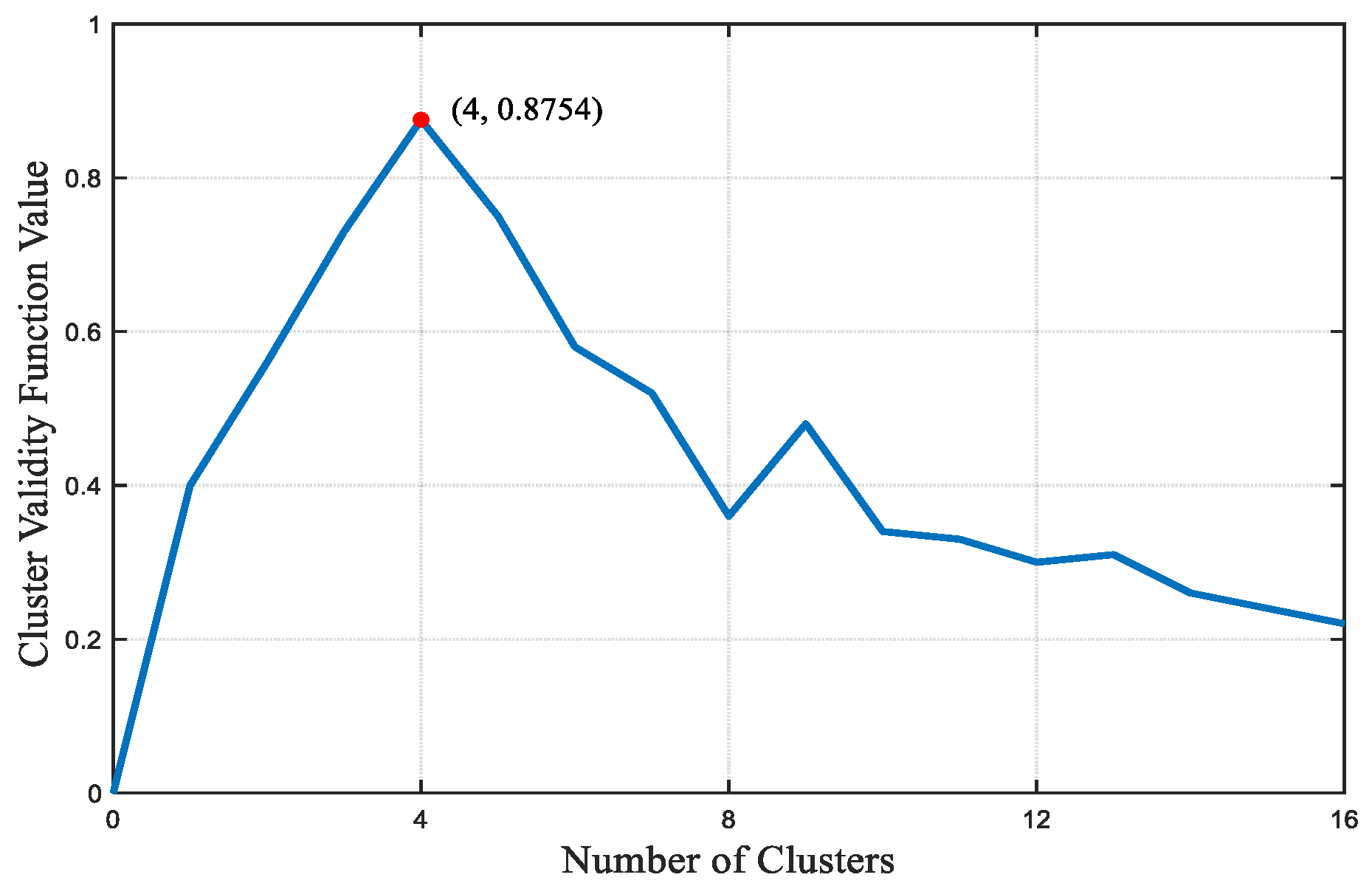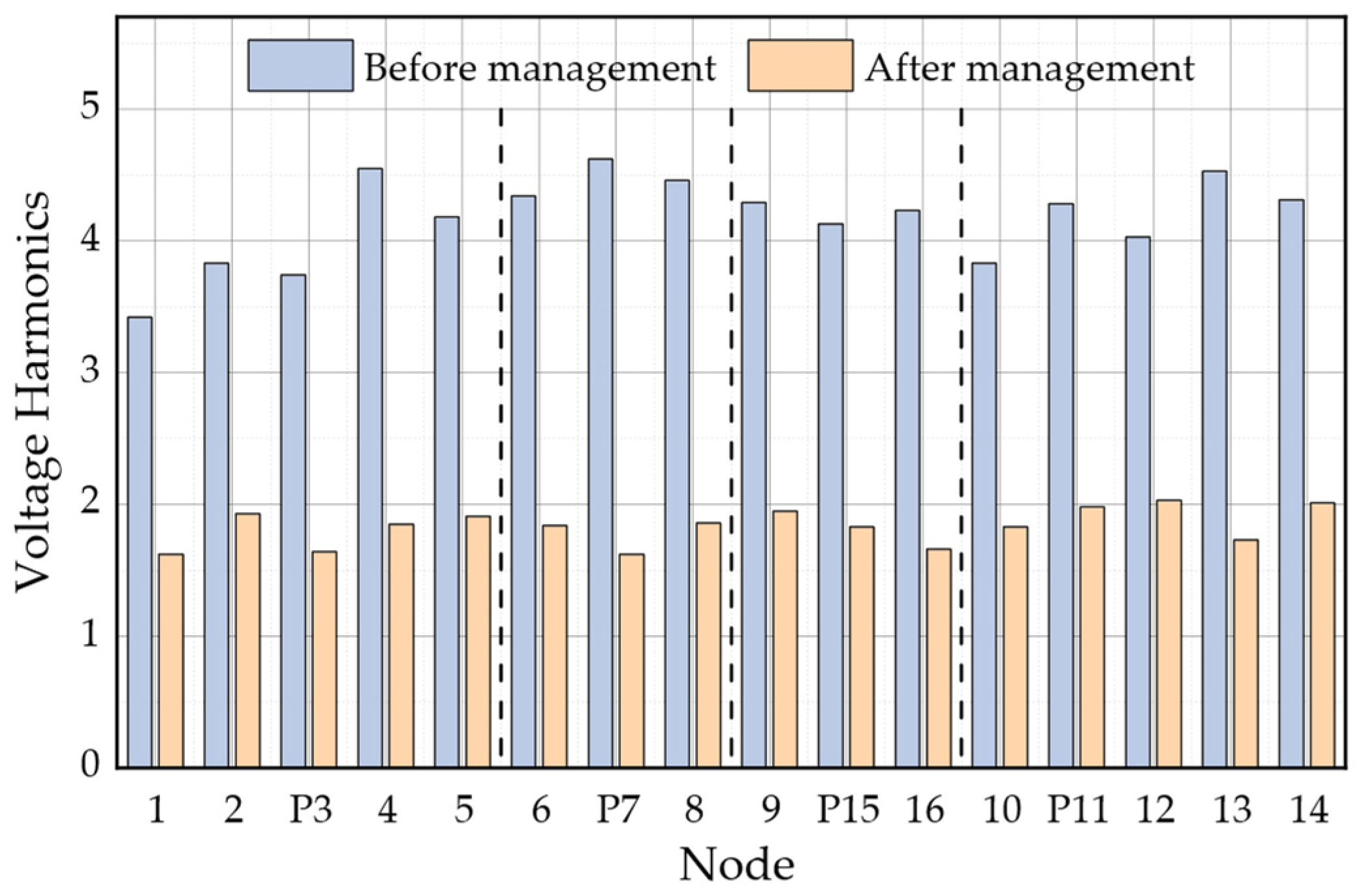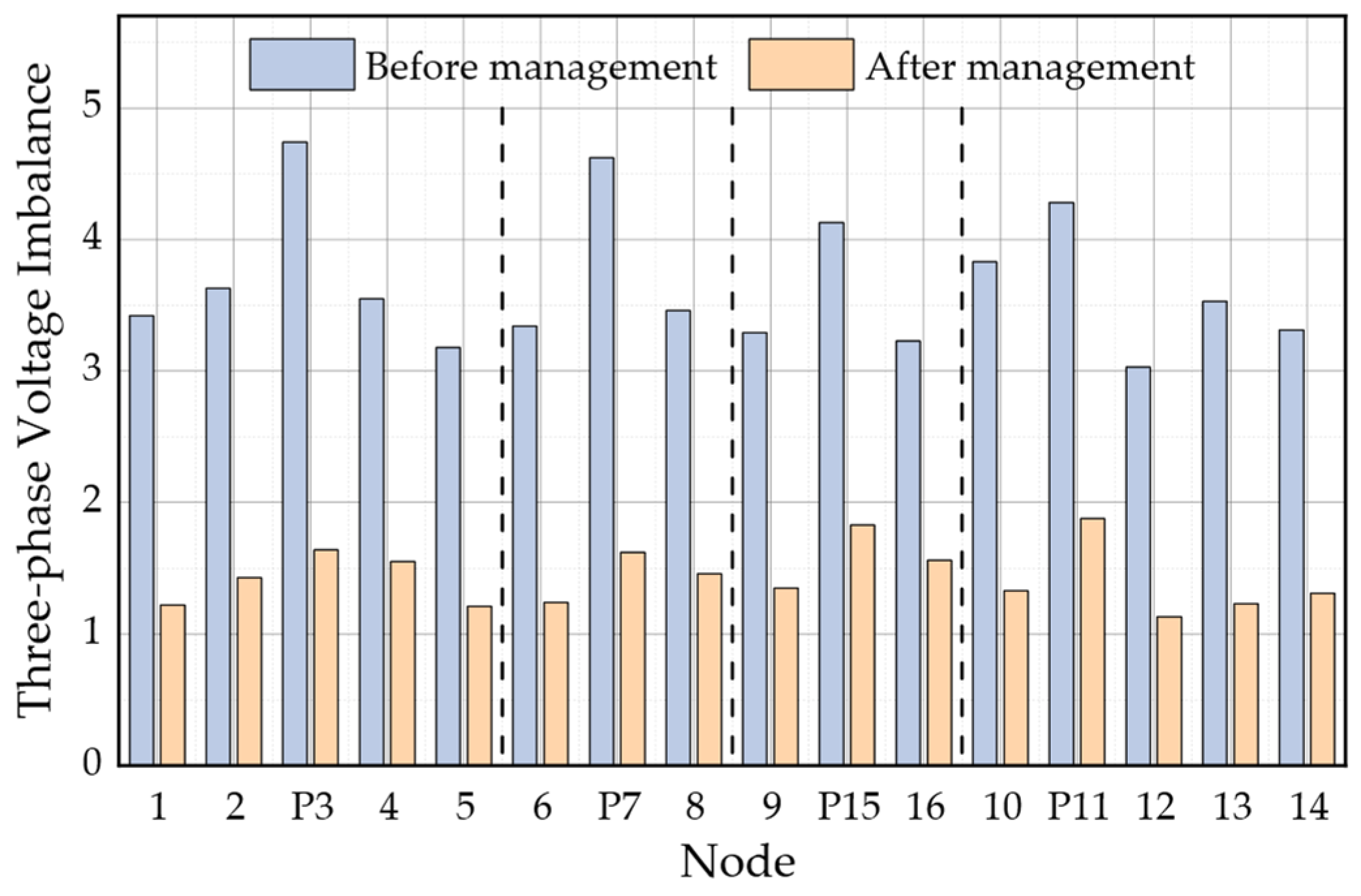A Collaborative Governance Strategy for Power Quality in AC/DC Distribution Networks Considering the Coupling Characteristics of Both Sides
Abstract
:1. Introduction
- (i)
- Consider the photovoltaic grid-connected inverters in the distribution network to divide the power quality comprehensive management area of the AC and DC distribution network, which is conducive to the regionalization of power quality management.
- (ii)
- Use the remaining capacity of the grid-connected inverter to manage the power quality of the whole network, and realize the reasonable and effective allocation of its governance resources so as to realize the global coordinated management of power quality.
2. Mechanism of DC Ripple Generation Based on AC-DC Coupling Characteristics
2.1. Ripple Analysis Caused by Voltage Harmonics
2.2. Ripple Analysis Caused by Voltage Asymmetry
3. AC Side Power Quality Zoning Strategy Considering Distributed Photovoltaic Governance Resources
3.1. Comprehensive Model for Voltage Sensitivity
3.1.1. Harmonic Voltage Sensitivity
3.1.2. Reactive Sensitivity
3.1.3. Three-Phase Imbalance Sensitivity
3.2. Division of Power Quality Zones in AC Subnetworks
3.3. Process of AC-Side Power Quality Zoning Strategy Considering Distributed Photovoltaic Governance Resources
- (i)
- A comprehensive voltage sensitivity model is equationed by integrating harmonic sensitivity, reactive power sensitivity, and three-phase imbalance sensitivity. This model takes into consideration the presence of distributed photovoltaic governance resources within the distribution network. It delineates photovoltaic control areas that effectively address the three primary power quality indicators.
- (ii)
- The DDTW-FCM clustering and partitioning algorithm is harnessed to analyze time series data. This approach determines the optimal number of clusters through the maximization of the clustering validity function. Subsequently, it assigns nodes to respective classes, thereby facilitating the delineation of power quality areas. Each area’s central node, closest to the cluster center, is identified as the pilot node for regional governance.
- (iii)
- The comprehensive management area of power quality is defined based on the spatial relationship between the two types of areas through the following methods: if the photovoltaic control area is entirely encompassed within the power quality area, the comprehensive management area is set to be the extent of the photovoltaic control area. In cases where the regions overlap, the approach involves amalgamating the PV control region with the corresponding power quality region of the predominant node it encompasses.
4. Optimal Allocation of Distributed Governance Resources Considering Active Photovoltaic Grid-Connected Converter Optimization
4.1. Functional Analysis of Power Quality Control in Photovoltaic Grid-Connected Inverters
4.2. Power Quality Optimization Strategy Utilizing Adjustable Capacity in Photovoltaic Grid-Connected Systems
- (i)
- A comprehensive voltage sensitivity model is equationed by integrating harmonic sensitivity, reactive power sensitivity, and three-phase imbalance sensitivity. This model takes into consideration the presence of distributed photovoltaic governance resources within the distribution network. It delineates photovoltaic control areas that effectively address the three primary power quality indicators.
- (ii)
- If SRE ≥ QN0, and satisfies
- (iii)
- If SRE ≤ QN0, and satisfy, then no compensation will be invested.
5. Case Analysis
6. Conclusions
- (i)
- In the problem of power quality on both sides of AC and DC, the DC ripple generation mechanism corresponding to the harmonics and asymmetry of the AC subnetwork voltage is derived and analyzed. With the help of the inverter’s fast response and high-precision adjustment capabilities, it can quickly identify and respond to current distortions and imbalances and achieve effective control.
- (ii)
- Based on the comprehensive voltage sensitivity model to determine the photovoltaic control area, the DDTW-FCM cluster partition algorithm is used to divide the power quality area and its dominant node, and four comprehensive power quality control areas of the AC and DC distribution network are determined.
- (iii)
- Considering the power quality management function of PVMFGCI, the optimal compensation coefficients of power quality indicators in the four regions are solved based on its remaining capacity, which effectively improves the harmonics, reactive power, and imbalance of the AC side, and reduces the ripple of the DC bus wave, to achieve a more reasonable and economical AC and DC distribution network power quality collaborative governance.
Author Contributions
Funding
Institutional Review Board Statement
Informed Consent Statement
Data Availability Statement
Conflicts of Interest
Nomenclature
| Abbreviations | |
| AC/DC | alternating current/direct current |
| PVMFGCI | photovoltaic multifunctional grid-connected inverter |
| DG | distributed generator |
| APF | active power filter |
| SVG | static var generator |
| UPQC | unified power quality conditioner |
| VSC | voltage source converter |
| DTW | dynamic time warping |
| ED | edit distance |
| DDTW | dynamic derivative time warping |
| Variables | |
| UAPF.h, IAPF.h | h-order harmonic compensation voltage/current vector produced by the photovoltaic grid-connected inverter |
| mij | the harmonic control sensitivity of the photovoltaic grid-connected inverter from node j to node i |
| weight associated with the h-order harmonic voltage in node i | |
| , Sij, Bij | harmonic/reactive power/three-phase imbalance sensitivity |
| Wij | comprehensive voltage sensitivity |
| VUFi, | the voltage imbalance degree of node i before/after compensation |
| P | the optimal number of clusters |
| Sh, Sq, S2 | capacities of the DG grid-connected inverter for harmonic control, reactive power compensation, and three-phase imbalance control |
| coefficients for harmonic control, reactive power compensation, and three-phase imbalance control of the remaining capacity of PVMFGCI | |
| Ip1, Iph, Ipq, Ip2 | PVMFGCI output active current, harmonic wave control, reactive power compensation, and three-phase imbalance control current |
| harmonics, reactive power, and three-phase imbalance coefficients before compensation and after compensation | |
References
- Wen, Y.; Yang, W.; Wang, R.; Xu, W.; Ye, X.; Li, T. Review and Prospect of Toward 100% Renewable Energy Power Systems. Proc. Chin. Soc. Electr. Eng. 2020, 40, 1843–1855. [Google Scholar]
- Zhang, W.; Wei, Z.; Guo, Y.; Hu, R.; Liu, J.; Jiang, Z. Optimal Daily Economic Operation of AC/DC Distribution Network with Hybrid Energy Storage. High Volt. Eng. 2022, 48, 565–574. [Google Scholar]
- Ma, Z.; Wei, Z.; Chen, S.; Zheng, Y.; Wu, T. Active-Reactive Power Optimal Dispatch of AC/DC Distribution Network Based on Soft Open Point. Autom. Electr. Power Syst. 2023, 47, 48–58. [Google Scholar]
- Xu, Y.; Liu, H.; Xiong, X.; Ji, Y.; Shao, Y.; Zhang, H.; Sun, L.; Wu, M. Key Technologies and Development Modes of Flexible Interconnection of Low-voltage Distribution Station Area. Proc. Chin. Soc. Electr. Eng. 2022, 42, 3986–4000. [Google Scholar]
- Hu, P.; Zhu, N.; Jiang, D.; Ju, P.; Liang, Y.; Wu, B. Research Progress and Prospects of Key Technologies of Flexible Interconnected Smart Distribution Network. Autom. Electr. Power Syst. 2021, 45, 2–12. [Google Scholar]
- Yang, X.; Su, J.; Lv, Z. Overview on micro-grid technology. Proc. Chin. Soc. Electr. Eng. 2014, 34, 57–70. [Google Scholar]
- Li, X.; Guo, L.; Wang, C. Key technologies of DC microgrids: An overview. Proc. Chin. Soc. Electr. Eng. 2016, 36, 2–17. [Google Scholar]
- Pei, X.; Zhou, W.; Kang, Y. Analysis and Calculation of DC-Link Current and Voltage Ripples for Three-Phase Inverter with Unbalanced Load. IEEE Trans. Power Electron. 2015, 30, 5401–5412. [Google Scholar] [CrossRef]
- Kalyan, C.N.S.; Goud, B.S.; Kishan, H.; Ramineni, P.; Kumar, B.P.; Kumar, T.A. Donkey and Smuggler Optimization Algorithm-based Degree of Freedom Controller for Stability of Two Area Power System with AC-DC Links. In Proceedings of the 2022 IEEE 7th International Conference on Recent Advances and Innovations in Engineering (ICRAIE), Mangalore, India, 1–3 December 2022; pp. 461–466. [Google Scholar]
- Guo, Z.; Le, Q.; Guo, L. DC Bus Voltage Ripple Suppression Method in AC-DC Hybrid Microgrid. Power Syst. Technol. 2017, 41, 2896–2904. [Google Scholar]
- Jiao, J.; Jia, Q.; Wang, N. Ripple formation mechanism and superposition characteristics of flexible DC distribution network. Power Syst. Technol. 2017, 41, 1726–1733. [Google Scholar]
- Akagi, H.; Fujita, H.; Wada, K. Shunt active filter based on voltage detection for harmonic termination of a radial power distribution line. IEEE Trans. Ind. Appl. 1999, 35, 638–645. [Google Scholar] [CrossRef]
- Munir, H.M.; Zou, J.; Xie, C.; Li, K.; Zhao, X.; Guerrero, J.M. Direct harmonic voltage control strategy for shunt active power filter. In Proceedings of the 43rd Annual Conference of the IEEE Industrial Electronics Society, IECON 2017, Beijing, China, 29 October–1 November 2017. [Google Scholar]
- Oghorada, O.J.K.; Zhang, L. Analysis of star and delta connected modular multilevel cascaded converter-based STATCOM for load unbalanced compensation. Int. J. Electr. Power Energy Syst. 2018, 95, 341–352. [Google Scholar] [CrossRef]
- Srilakshmi, K.; Srinivas, N.; Balachandran, P.K.; Reddy, J.G.P.; Gaddameedhi, S.; Valluri, N.; Selvarajan, S. Design of Soccer League Optimization Based Hybrid Controller for Solar-Battery Integrated UPQC. IEEE Access 2022, 10, 107116–107136. [Google Scholar] [CrossRef]
- Ramadevi, A.; Srilakshmi, K.; Balachandran, P.K.; Colak, I.; Dhanamjayulu, C.; Khan, B. Optimal Design and Performance Investigation of Artificial Neural Network Controller for Solar- and Battery-Connected Unified Power Quality Conditioner. Int. J. Energy Res. 2023, 2023, 3355124. [Google Scholar] [CrossRef]
- Srilakshmi, K.; Sujatha, C.N.; Balachandran, P.K.; Mihet-Popa, L.; Kumar, N.U. Optimal Design of an Artificial Intelligence Controller for Solar-Battery Integrated UPQC in Three Phase Distribution Networks. Sustainability 2022, 14, 13992. [Google Scholar] [CrossRef]
- Lashab, A.; Sera, D.; Guerrero, J.M. Harmonics Mitigation in Cascaded Multilevel PV Inverters during Power Imbalance between Cells. In Proceedings of the 19th IEEE International Conference on Environment and Electrical Engineering and 2019 IEEE Industrial and Commercial Power Systems Europe, EEEIC/I and CPS Europe 2019, Genoa, Italy, 11–14 June 2019. [Google Scholar]
- Bojoi, R.I.; Limongi, L.R.; Roiu, D.; Tenconi, A. Enhanced power quality control strategy for single-phase inverters in distributed generation systems. IEEE Trans. Power Electron. 2011, 26, 798–806. [Google Scholar] [CrossRef]
- Safa, A.; Berkouk, E.M.; Messlem, Y.; Gouichiche, A. An improved sliding mode controller for a multifunctional photovoltaic grid tied inverter. J. Renew. Sustain. Energy 2017, 9, 323–329. [Google Scholar] [CrossRef]
- Preetha, K.P.; Jayanand, B.; Reji, P. Power quality enhancement using Distributed Generation inverters with active power control. In Proceedings of the IEEE International Conference on Technological Advancements in Power and Energy, TAP Energy 2015, Kollam, India, 24–26 June 2015. [Google Scholar]
- Dong, H.; Yuan, S.; Han, Z.; Ding, X.; Ma, S.; Han, X. A Comprehensive Strategy for Power Quality Improvement of Multi-Inverter-Based Microgrid with Mixed Loads. IEEE Access 2018, 6, 30906–30916. [Google Scholar] [CrossRef]
- Chai, Y.; Guo, L.; Wang, C.; Zhao, Z.; Du, X.; Pan, J. Network Partition and Voltage Coordination Control for Distribution Networks with High Penetration of Distributed PV Units. IEEE Trans. Power Syst. 2018, 33, 3396–3407. [Google Scholar] [CrossRef]
- Liang, H.; Ma, J. Develop Load Shape Dictionary through Efficient Clustering Based on Elastic Dissimilarity Measure. IEEE Trans. Smart Grid 2021, 12, 442–452. [Google Scholar] [CrossRef]
- Wang, H.-Y.; Wang, J.-S.; Wang, G. Clustering Validity Function Fusion Method of FCM Clustering Algorithm Based on Dempster–Shafer Evidence Theory. Int. J. Fuzzy Syst. 2022, 24, 650–675. [Google Scholar] [CrossRef]
- Huang, H.; Zhao, W.; Wang, H. Suppression Method of DC Voltage Pulsation in Three—Phase Four—Wire APF. In Proceedings of the International Conference on Wireless Power Transfer, ICWPT 2022, Chongqing, China, 2–5 December 2022; pp. 893–900. [Google Scholar]
- Karasala, C.; Lekkala, R.R.; Myneni, H.; Ganjikunta, S.K. PV Grid-Connected Inverter with DC Voltage Regulation in CCM and VCM Operation to Reduce Switching Losses. IEEE Trans. Ind. Electron. 2023, 70, 11262–11275. [Google Scholar] [CrossRef]
- Guo, W.; Xu, W. Research on optimization strategy of harmonic suppression and reactive power compensation of photovoltaic multifunctional grid connected inverter. Int. J. Electr. Power Energy Syst. 2023, 145, 108649. [Google Scholar] [CrossRef]
- Li, Z.; Li, G.; Zhang, J. Power quality variable weight comprehensive evaluation and multiobjective optimazation of multifunctional grid-connected inverter. Acta Energiae Solaris Sin. 2022, 43, 515–521. [Google Scholar]
- Tian, S.; Jia, Q.; Xue, S.; Yu, H.; Qu, Z.; Gu, T. Collaborative optimization allocation of VDAPFS and SVGs for simultaneous mitigation of voltage harmonic and deviation in distribution networks. Int. J. Electr. Power Energy Syst. 2020, 120, 106034. [Google Scholar] [CrossRef]








| Node | 5th Harmonic Current/A | 7th Harmonic Current/A | 11th Harmonic Current/A | 13th Harmonic Current/A |
|---|---|---|---|---|
| 2 | 12.3 | 8.1 | 5.7 | 3.3 |
| 4 | 13.7 | 6.6 | 4.2 | 2.5 |
| 7 | 16.7 | 9.3 | 6.5 | 4.1 |
| 8 | 8.4 | 5.1 | 3.4 | 1.1 |
| 11 | 9.8 | 4.7 | 3.5 | 0.4 |
| 13 | 15.6 | 9.1 | 5.8 | 1.3 |
| 15 | 16.9 | 7.6 | 3.1 | 2.6 |
| Area | Nodes with Photovoltaic Control Capability | Managed Nodes |
|---|---|---|
| R1 | 3 | 1, 2, 3 |
| R2 | 7 | 6, 7, 8 |
| R2 | 13 | 11, 12, 13, 14 |
| R4 | 15 | 15, 16 |
| Area | Node for Regional Division | Dominant Node |
|---|---|---|
| I | 1, 2, 3, 4, 5 | 3 |
| II | 6, 7, 8 | 7 |
| III | 9, 15, 16 | 15 |
| IV | 10, 11, 12, 13, 14 | 11 |
| Area | Nodes with Photovoltaic Control Capability | Active Grid Connection/kW | Compensation Coefficient |
|---|---|---|---|
| I | 3 | 15 | (0.284, 0.170, 0.152) |
| II | 7 | 15 | (0.165, 0.201, 0.138) |
| III | 13 | 15 | (0.328, 0.272, 0.146) |
| IV | 15 | 15 | (0.406, 0.309, 0.167) |
Disclaimer/Publisher’s Note: The statements, opinions and data contained in all publications are solely those of the individual author(s) and contributor(s) and not of MDPI and/or the editor(s). MDPI and/or the editor(s) disclaim responsibility for any injury to people or property resulting from any ideas, methods, instructions or products referred to in the content. |
© 2023 by the authors. Licensee MDPI, Basel, Switzerland. This article is an open access article distributed under the terms and conditions of the Creative Commons Attribution (CC BY) license (https://creativecommons.org/licenses/by/4.0/).
Share and Cite
Wang, J.; Qin, L.; Xiang, Y.; Ren, P.; Tang, X.; Ruan, J.; Liu, K. A Collaborative Governance Strategy for Power Quality in AC/DC Distribution Networks Considering the Coupling Characteristics of Both Sides. Sensors 2023, 23, 7868. https://doi.org/10.3390/s23187868
Wang J, Qin L, Xiang Y, Ren P, Tang X, Ruan J, Liu K. A Collaborative Governance Strategy for Power Quality in AC/DC Distribution Networks Considering the Coupling Characteristics of Both Sides. Sensors. 2023; 23(18):7868. https://doi.org/10.3390/s23187868
Chicago/Turabian StyleWang, Jiang, Liang Qin, Yang Xiang, Penghui Ren, Xu Tang, Jiangjun Ruan, and Kaipei Liu. 2023. "A Collaborative Governance Strategy for Power Quality in AC/DC Distribution Networks Considering the Coupling Characteristics of Both Sides" Sensors 23, no. 18: 7868. https://doi.org/10.3390/s23187868





